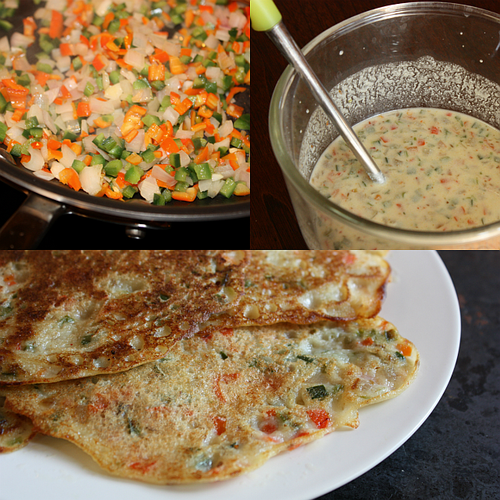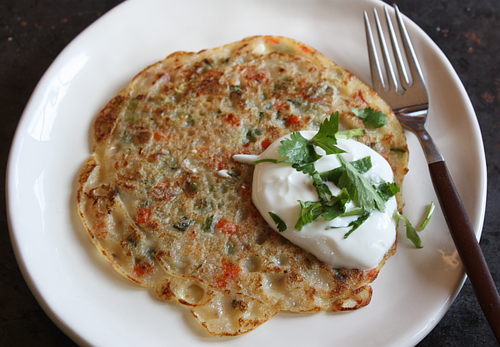The temperature began dropping last week and my
response was to make an warming Indian meal. I hankered for Indian crepes but
didn’t want to ferment and grind batter. Something simple was in order and rava
dosas came to mind. The southern Indian crepe is made with readily available
ingredients and the batter does not require fermentation. Mix it up and an hour
later, it’s ready.
I had them with a light curry, chutney and raita.
The next day we had the crepes for lunch with a dollop of yoghurt that I mixed
up into a quick raita, and a salad. I based the recipe below from one in Julie
Sahni’s magnificent Savoring India cookbook.
She used bell pepper and lots of
serranos and dried chile flakes. I dialed up the fruity fresh chile heat by
using pasilla and Fresnos and lowered the others. Regardless of the chile combination,
the result was something to rave about. We didn’t mind eating rava dosas two days
in a row.

I’d never made rava dosa before and there were
extra lacy, crisp versions online. I stuck to Sahni’s recipe because she said
it was an ancient one. It's nice to check out old school renditions of foods to understand their roots. If you don’t know Julie Sahni, she is one of the
foremost Indian food authorities, author of Classic Indian Cooking and Classic
Indian Vegetarian and Grain Cooking. A scholarly woman who rocks in the
kitchen.
Rava dosa tips and tweaks:
- Where to buy semolina and rice flour?
At an Indian market or the bulk section of a health food store or a place
like Whole Foods. It’s much cheaper than getting semolina for making Italian
pasta. - When prepping a day in advance,
mix the batter and cooking the vegetables. Refrigerate them separately.
Return them to room temperature and combine before you make the crepes. - For appetizer size portions, make these as small as silver dollar pancakes. Or cut the ones below into wedges.
- Accompaniments: You can serve this
with a sambhar. See the note section of the Dal
Dhokli recipe on Asian Dumpling Tips for guidance. Or, enjoy the
crepes with a coconut
cilantro chutney.
RECIPE
Semolina
Crepes with Chile
Rava Dosa
Yield: 8 crepes, to serve 4
Ingredients
- 4 ounces (115 g) fine-grind semolina
- 2 ounces (60 g) rice flour, any brand, Asian or
not - 1 ½ ounces (45 g) unbleached all-purpose flour
- 2 cups (480 ml) water
- 1 tablespoon canola oil, plus more as needed
- 1 large pasilla chile or 2 large jalapeno chiles,
seeded and finely diced - 2 Fresno or other moderately-hot red chile, seeded
and finely diced - 1 extra-large shallot, chopped (½ cup / 2.5 oz /
75 g) - 1 or 2 serrano chiles, unseeded, thinly sliced
- About 1 teaspoon cumin seeds, pounded with mortar
and pestle - ¼ to ¾ teaspoon dried red pepper flakes
- 2 tablespoons chopped cilantro leaves
- About ¾ teaspoon salt
- ½ cup Greek yoghurt, full fat or 2% preferred
Instructions
- For the batter, put the semolina, rice flour and
regular flour in a bowl. Make a well in the center and whisk in the water until
smooth. Cover and set aside to thicken at room temperature, 1 hour. Or
refrigerate overnight, returning the batter to room temp before using. - In a medium nonstick skillet, heat the oil over
medium-high heat. Add all three types of chiles, shallot, dried red chile
flakes and cumin. Cook for 3 to 5 minutes, stirring constantly, until slightly
softened and halfway cooked. Off heat, stir in 1 tablespoon of the cilantro.
Let cool briefly then dump into the batter. Taste and season with the salt. You
should have about 2 ⅔ cups (630 ml) of batter, which should be pourable and
thick like buttermilk. - For a quick yoghurt raita, mix the yoghurt with 1
to 2 tablespoons water to soften and turn creamy. Season with salt and if you
like, pound a little more cumin and add to the to the yoghurt. Set aside. - To make the crepes, reheat the nonstick skillet or
a griddle over medium-high heat. Brush with a little oil. For each crepe, ladle
about ⅓ cup (80 ml) of the batter onto the pan. Swirl the skillet or use the
bottom of the ladle to spread the batter to about the thickness of a bean
sprout. It does not need to be a perfect circle. Drizzle a teaspoon or so of
oil around the edge, let cook until browned, nearly 2 minutes. Use a spatula to
turn over and cook the other side for 30 to 45 seconds longer. Repeat to make
more from the remaining batter. As you work, you can add extra water to thin
out the batter and make the dosas a little more crisp or thinner. Adjust the
heat accordingly. - These crepes soften as they cool. If you want to return a bit of their chewy-crispness, throw them back into the skilet or onto the griddle for a short spell. Serve the crepes with a plop of yoghurt and sprinkle of cilantro.
If you’re an
old hand at making or eating rava dosas, do you have tips to add?
Related posts:


















Marshall says
This is the 3rd best dosa variety I like after masala dosa and onion dosa or uthappam, which are much delicious like this. Want to taste this dosa in your method.
Andrea Nguyen says
Marshall, you're a dosa maniac. Love it. Indian crepes are marvelous, aren't they?!
TinCook says
With all the stuff in it, it kinda reminds me of a chile jeon (Korean pancake).
I take it that it doesn't make a difference if it's glutinous rice flour or regular rice flour?
Also, I made the garlic/5-spice thit noung from your Vietnamese book for 60 people today. It was very well received.
Andrea Nguyen says
The rava dosa will be softer and chewier with the glutinous rice flour. If you add extra oil, it could be crispy chewy.
Whoa, you made the pork for 60 people? I'm am duly impressed and honored!
TinCook says
It was for this place I volunteer at. We'd gotten 50lbs of broken jasmine rice donated to us. So you know I had to do some Vietnamese food. Also made the nouc cham. Good tip about the combination of vinegar and citrus (ended up using lemon and white wine vin). Added some salad and some pickled veg, and I made a pretty decent com tam plate.
The power of fish sauce just blows me away. I'm working up the nerve to try shrimp paste next.
John Bell says
Hi Andrea,
Hate to be a wet blanket, but it's been my sole task to get everyone on the same page with pasilla/poblano peppers.
Poblanos are often labeled pasillas North of the Mexican border.
When you're buying a fresh chile labeled "pasilla," it's actually a poblano.
A pasilla is a dried chilaca chile; which I've yet to come across, even in Arizona.
Poblano dried, is a ancho.
Love your site, and your books. Will be trying this dosa recipe, with POBLANOS! 🙂
Cheers!
John B.
Kate Leahy says
This sounds like a delicious savory breakfast dish--actually, a good dish to eat any time of the day. Thanks for sharing. I'm past due for a run to Vik's, and now I have a few more items to add to the grocery list. BTW, I finally got my copy of Asian Tofu back!
Andrea Nguyen says
John, Thank you for the reminder and clarification. It's hard with ethnic food ingredient labeling. Oye, ai-ya, dios mio.
Andrea Nguyen says
Kate, this is so darn doable with co-op ingredients. A dosa breakfast is very nice indeed. Glad you got Asian Tofu back in your hands. They should have bought their own... grrrr.
reeta says
simply love the way you've explained the dosa recipe! check out the birthplace of dosa here: http://delhifoodies.blogspot.in/2011/06/delhi-meets-bengaluru-birthplace-of.html
cheers!